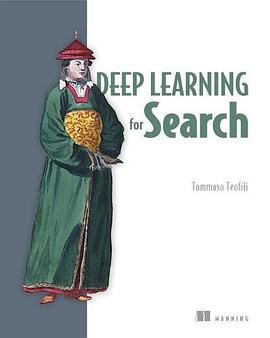Deep Learning for Search
Douban
Tommaso Teofili
résumé
Deep Learning for Search teaches you to improve your search results with neural networks. You’ll review how DL relates to search basics like indexing and ranking. Then, you’ll walk through in-depth examples to upgrade your search with DL techniques using Apache Lucene and Deeplearning4j. As the book progresses, you’ll explore advanced topics like searching through images, translating user queries, and designing search engines that improve as they learn!
what's inside
Accurate and relevant rankings
Searching across languages
Content-based image search
Search with recommendations
contents
Foreword
Preface
Acknowledgments
About this book
About the author
About the cover illustration
Part 1. Search meets deep learning
Chapter 1. Neural search
1.1. Neural networks and deep learning
1.2. What is machine learning?
1.3. What deep learning can do for search
1.4. A roadmap for learning deep learning
1.5. Retrieving useful information
1.6. Unsolved problems
1.7. Opening the search engine black box
1.8. Deep learning to the rescue
1.9. Index, please meet neuron
1.10. Neural network training
1.11. The promises of neural search
Summary
Chapter 2. Generating synonyms
2.1. Introduction to synonym expansion
2.2. The importance of context
2.3. Feed-forward neural networks
2.4. Using word2vec
2.5. Evaluations and comparisons
2.6. Considerations for production systems
Summary
Part 2. Throwing neural nets at a search engine
Chapter 3. From plain retrieval to text generation
3.1. Information need vs. query: Bridging the gap
3.2. Learning over sequences
3.3. Recurrent neural networks
3.4. LSTM networks for unsupervised text generation
3.5. From unsupervised to supervised text generation
3.6. Considerations for production systems
Summary
Chapter 4. More-sensitive query suggestions
4.1. Generating query suggestions
4.2. Lucene Lookup APIs
4.3. Analyzed suggesters
4.4. Using language models
4.5. Content-based suggesters
4.6. Neural language models
4.7. Character-based neural language model for suggestions
4.8. Tuning the LSTM language model
4.9. Diversifying suggestions using word embeddings
Summary
Chapter 5. Ranking search results with word embeddings
5.1. The importance of ranking
5.2. Retrieval models
5.3. Neural information retrieval
5.4. From word to document vectors
5.5. Evaluations and comparisons
Summary
Chapter 6. Document embeddings for rankings and recommendations
6.1. From word to document embeddings
6.2. Using paragraph vectors in ranking
6.3. Document embeddings and related content
Summary
Part 3. One step beyond
Chapter 7. Searching across languages
7.1. Serving users who speak multiple languages
7.2. Statistical machine translation
7.3. Working with parallel corpora
7.4. Neural machine translation
7.5. Word and document embeddings for multiple languages
Summary
Chapter 8. Content-based image search
8.1. Image contents and search
8.2. A look back: Text-based image retrieval
8.3. Understanding images
8.4. Deep learning for image representation
8.5. Working with unlabeled images
Summary
Chapter 9. A peek at performance
9.1. Performance and the promises of deep learning
9.2. Indexes and neurons working together
9.3. Working with streams of data
Summary
Looking forward